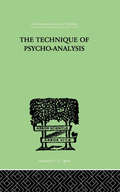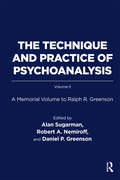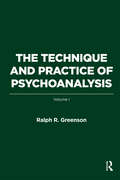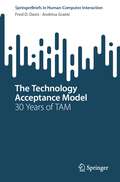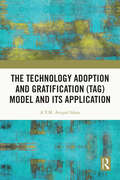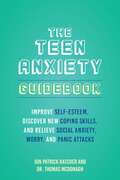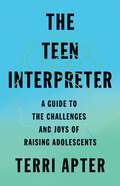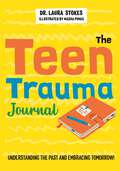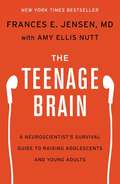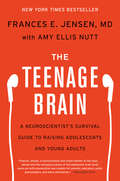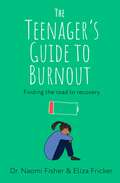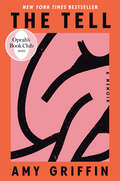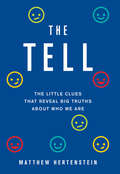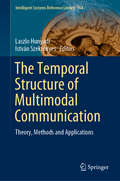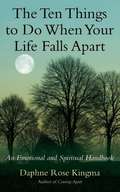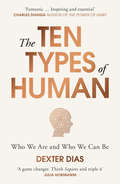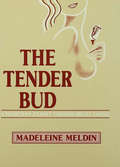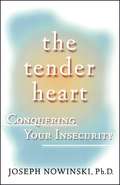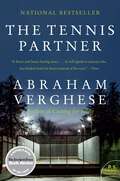- Table View
- List View
The Teaching of Thinking
by D. N. Perkins R. S. Nickerson E. E. SmithFirst published in 1985. This book was created due to involvement of the authors to develop a course to enhance thinking skills. A main aim of which was to determine what is known about the teaching of thinking from current research literature and from the results of efforts to develop cognitive enhancement programs. The primary focus is on intentional, purposeful, goal-oriented thinking-thinking, if you will, for the express purpose of realizing some specific objective.
The Technique Of Psycho-Analysis (International Library Of Psychology Ser.)
by Forsyth, DavidFirst Published in 1999. Routledge is an imprint of Taylor & Francis, an informa company.
The Technique and Practice of Psychoanalysis: A Memorial Volume to Ralph R. Greenson
by Ralph R. GreensonThe discovery of several incomplete chapters of Ralph R. Greenson's long-awaited Volume II of The Technique and Practice of Psychoanalysis form the cornerstone of this memorial to a man considered by many to be the best clinical psychoanalyst of his generation. Using the detailed outlines of the chapters that Greenson had intended to write, the editors solicited prominent American psychoanalysts to cover the planned content areas. Such adherence to Greenson's plan makes this a worthy companion to Volume I.
The Technique and Practice of Psychoanalysis: Volume I
by Ralph R. GreensonThis systematic and comprehensive volume, written in a lively and clear style, is devoted essentially to the fundamentals of psychoanalytic technique: transference and resistance. The author approaches psychoanalytic technique from a classical theoretical framework, but he frequently gives an entirely fresh view of traditionally accepted procedures. His most important new contribution consists in the clear distinction between the patient's 'real relationship' to the analyst, the 'working alliance', and the transference relationship. His discussion of the contradictory and often conflicting demands which each of these elements makes on the technical skills of the analyst is particularly illuminating. In many fascinating case illustrations, he shows how the analyst carries out therapeutic psychoanalysis while respecting the diversity of psychic constellations in different patients and at different points in their analyses. This book can be recommended - without qualification - to the beginning student because of the thorough clarification and documentation of the basic principles of psychoanalytic technique.
The Technology Acceptance Model: 30 Years of TAM (Human–Computer Interaction Series)
by Fred D. Davis Andrina GranićThis SpringerBrief discusses the origins, emergence, evolution, and future of the Technology Acceptance Model (TAM). TAM, simple yet powerful, has been extensively validated, standing as a leading scientific paradigm and a reliable model for explaining, predicting, and improving user acceptance across a spectrum of technological deployments. Over more than three decades since the introduction of TAM, numerous extensions have emerged, incorporating additional variables and collectively referred to as “TAM++”. However, perceived usefulness and perceived ease of use remain the basic beliefs of the core TAM model. The introductory chapter “Once upon a TAM” focuses on the challenging search for a user acceptance crystal ball, showing that it is indeed possible to consistently predict, explain, and improve user acceptance. “Evolution of TAM” traces the model's growth and adaptability, exploring the proliferation of selected TAM-related behavioural intention models, several integrated theoretical approaches, the quest for other behavioural intention antecedents, and TAM’s versatile applications in various contexts. “Revolution of TAM” presents an in-depth systematic review, encompassing a meta-analysis of selected TAM reviews and meta-analyses, and a narrative review of representative primary studies, providing a thorough and extensive understanding of the TAM universe. The epilogue “What will the Future of TAM be Like?” provides insights into its dynamic future. This SpringerBrief concludes with seven actionable principles, serving as a strategic guide for those aiming to customize the TAM++ body of knowledge for application-oriented studies within a particular context. This comprehensive overview of TAM is a valuable source of information for researchers, practitioners, and all interested readers, especially those new to the field.
The Technology Adoption and Gratification (TAG) Model and Its Application
by A.Y.M. Atiquil IslamThe book introduces Technology Adoption and Gratification (TAG) Model and its application in higher education, technical and vocational education, postsecondary education and cross-culture.The author demonstrates the fundamentals of technology adoption and gratification—what it comprises and how to expand it. The book describes how the viability of the TAG model was tested using Structural Equation Modeling for teaching, learning and research purposes, which could assist academicians and practitioners in performing technological measurements in all arenas of education.The book will attract researchers, students and practitioners who have backgrounds in educational technology, educational psychology, library & information science, technical and vocational education or STEM education.
The Technology of Orgasm: "Hysteria," the Vibrator, and Women's Sexual Satisfaction (Johns Hopkins Studies in the History of Technology #24)
by Rachel P. MainesWinner of the Herbert Feis Prize from the American Historical Association Winner of the AFGAGMAS Biennial Book AwardWinner of the Science Award from the American Foundation for Gender and Genital Medicine From the time of Hippocrates until the 1920s, massaging female patients to orgasm was a staple of medical practice among Western physicians in the treatment of "hysteria," an ailment once considered both common and chronic in women. Doctors loathed this time-consuming procedure and for centuries relied on midwives. Later, they substituted the efficiency of mechanical devices, including the electric vibrator, invented in the 1880s. In The Technology of Orgasm, Rachel Maines offers readers a stimulating, surprising, and often humorous account of hysteria and its treatment throughout the ages, focusing on the development, use, and fall into disrepute of the vibrator as a legitimate medical device.
The Teen Anxiety Guidebook: Improve Self-Esteem, Discover New Coping Skills, and Relieve Social Anxiety, Worry, and Panic Attacks
by Dr. Thomas McDonagh Jon Patrick HatcherBreak free from anxiety and manage stress with simple strategies and cognitive behavioral therapy (CBT) techniques in this straightforward and encouraging handbook.Keeping up with friendships, relationships, school, extracurriculars, and social media is already a lot of work. And when anxiety spikes, it sometimes feels like it&’s impossible to keep your life on track. You might feel like you&’re in a never-ending downward spiral. That&’s where this book comes in. The Teen Anxiety Guidebook offers dozens of beneficial quizzes, activities, tips and CBT-based advice to help you: Identify your most common anxiety triggers Learn essential coping skills to prevent anxiety attacks Redirect risky behavior, including substance abuse and self-harm Understand the options of therapy and medication Overcome the spike-and-relapse cycle From mindfulness meditation to diaphragmatic breathing, the exercises in this book will give you the tools you need to redirect negative thought and behavioral patterns and navigate the difficulties of life.
The Teen Interpreter: A Guide to the Challenges and Joys of Raising Adolescents
by Terri ApterThe Teen Interpreter is a generous roadmap for enjoying the most challenging, and rewarding, parenting years. Once children hit adolescence, it seems as if overnight “I love you” becomes “leave me alone,” and any question from a parent can be dismissed with one word: “fine.” But while they may not show it, teenagers rely on their parents’ curiosity, delight, and connection to guide them through this period of exuberant growth as they navigate complex changes to their bodies, their thought processes, their social world, and their self-image. In The Teen Interpreter, psychologist Terri Apter looks into teens’ minds—minds that are experiencing powerful new emotions and awareness of the world around them—to show how parents can revitalize their relationship with their children. She illuminates the rapid neurological developments of a teen’s brain, along with their new, complex emotions, and offers strategies for disciplining unsafe actions constructively and empathetically. Apter includes up-to-the moment case studies that shed light on the anxieties and vulnerabilities that today’s teens face, and she thoughtfully explores the positives and pitfalls of social media. With perceptive conversation exercises that synthesize research from more than thirty years in the field, Apter illustrates how teens signal their changing needs and identities—and how parents can interpret these signals and see the world through their teens’ eyes. The Teen Interpreter is a generous roadmap for enjoying the most challenging, and rewarding, parenting years.
The Teen Trauma Journal: Understanding the Past and Embracing Tomorrow!
by Laura StokesThis therapeutic journal provides you with the tools and coping strategies you need to better look after yourself. Covering topics such as attachment, thinking styles, self-esteem and new relationships, it looks at how early relationships and trauma may have impacted you, and supports you in planning for your future. Authored by experienced Consultant Clinical Psychologist Laura Stokes, this journal will be a source of support and guidance you as you navigate life's ups and downs.
The Teenage Brain: A Neuroscientist's Survival Guide To Raising Adolescents And Young Adults
by Frances E. Jensen Amy Ellis NuttNew York Times Bestseller<P><P> Drawing on her research knowledge and clinical experience, internationally respected neurologist—and mother of two boys—Frances E. Jensen, M.D., offers a revolutionary look at the science of the adolescent brain, providing remarkable insights that translate into practical advice for both parents and teenagers.<P> Driven by the assumption that brain growth was pretty much complete by the time a child began kindergarten, scientists believed for years that the adolescent brain was essentially an adult one—only with fewer miles on it. Over the last decade, however, the scientific community has learned that the teen years encompass vitally important stages of brain development.<P> Motivated by her personal experience of parenting two teenage boys, renowned neurologist Dr. Frances E. Jensen gathers what we’ve discovered about adolescent brain functioning, wiring, and capacity and, in this groundbreaking, accessible book, explains how these eye-opening findings not only dispel commonly held myths about the teenage years, but also yield practical suggestions that will help adults and teenagers negotiate the mysterious world of adolescent neurobiology.<P> Interweaving clear summary and analysis of research data with anecdotes drawn from her years as a parent, clinician, and public speaker, Dr. Jensen explores adolescent brain functioning and development in the contexts of learning and multitasking, stress and memory, sleep, addiction, and decision-making.<P> Rigorous yet accessible, warm yet direct, The Teenage Brain sheds new light on the brains—and behaviors—of adolescents and young adults, and analyzes this knowledge to share specific ways in which parents, educators, and even the legal system can help them navigate their way more smoothly into adulthood.
The Teenage Brain: A Neuroscientist's Survival Guide to Raising Adolescents and Young Adults
by Frances E. Jensen Amy Ellis NuttDrawing on her research, knowledge, and clinical experience, internationally respected neurologist--and mother of two boys--Frances E. Jensen, MD, offers a revolutionary look at the adolescent brain, providing remarkable insights that translate into practical advice both for parents and teenagers.Driven by the assumption that brain growth was almost complete by the time a child reached puberty, scientists believed for many years that the adolescent brain was essentially an adult one--only with fewer miles on it. Over the last decade, however, neurology and neuroscience have revealed that the teen years encompass vitally important stages of brain development.Motivated by her experience of parenting two teenagers, renowned neurologist Frances E. Jensen, MD, gathers what we've discovered about adolescent brain functioning and wiring, and in this groundbreaking, accessible book, explains how these eye-opening findings not only dispel commonly held myths about teens but also yield practical suggestions for adults and teenagers negotiating the mysterious and magical world of adolescent biology.Interweaving clear summary and analysis of research data with anecdotes drawn from her years as a clinician, researcher, and public speaker, Dr. Jensen explores adolescent brain functioning and development in the context of learning and multitasking, stress and memory, sleep, addiction, and decision making. Examining data connecting substance use to lingering memory issues and, sometimes, a lower adult IQ, The Teenage Brain explains why teenagers are not as resilient to the effects of drugs as we previously thought; reveals how multitasking impacts learning ability and concentration; and examines the consequences of stress on mental health during and beyond adolescence.Rigorous yet accessible, warm yet direct, The Teenage Brain sheds new light on the brains--and behaviors--of adolescents and young adults, and analyzes this knowledge to share specific ways in which parents, educators, and even the legal system can help them navigate their way more smoothly into adulthood in our ever challenging world.
The Teenager's Guide to Burnout: Finding the Road to Recovery
by Dr. Naomi Fisher Eliza FrickerAn essential guide for all teenagers experiencing stress and burnoutDoes any of this sound like you? - Lacking in energy and feeling that your life has lost its sparkle- Feeling like you can't ever quite relax- Unable to sleep despite being exhausted all the time- Finding that you don't really enjoy anything anymore, even things you used to love- Feeling that everyone is irritating and no one understands- Finding going to school really hard or not possible at all anymoreThen this book might help. These are signs that you are experiencing burnout − your battery has taken a battering and you are running on empty. Many people think burnout only happens to adults, but it's something lots of teenagers experience too. This book will help you to understand what burnout is, how you got there and what you can do to get back to a life you enjoy. We've written it to help you work out if you might be burnt out, and if so, what you can do about it. It will help you identify some of the ways that you might be getting stuck when you're trying to get better. You'll get some ideas as to what is and isn't helping. And if you decide that you aren't really burnt out but you're heading that way, this book has some ideas to stop it from happening in the future.Co-written by expert clinical psychologist Dr Naomi Fisher, who has helped many teenagers deal with the stresses and pressures of school and life, and by bestselling author and illustrator Eliza Fricker.
The Teenager's Guide to Burnout: Finding the Road to Recovery
by Dr. Naomi Fisher Eliza FrickerAn essential guide for all teenagers experiencing stress and burnoutDoes any of this sound like you? - Lacking in energy and feeling that your life has lost its sparkle- Feeling like you can't ever quite relax- Unable to sleep despite being exhausted all the time- Finding that you don't really enjoy anything anymore, even things you used to love- Feeling that everyone is irritating and no one understands- Finding going to school really hard or not possible at all anymoreThen this book might help. These are signs that you are experiencing burnout − your battery has taken a battering and you are running on empty. Many people think burnout only happens to adults, but it's something lots of teenagers experience too. This book will help you to understand what burnout is, how you got there and what you can do to get back to a life you enjoy. We've written it to help you work out if you might be burnt out, and if so, what you can do about it. It will help you identify some of the ways that you might be getting stuck when you're trying to get better. You'll get some ideas as to what is and isn't helping. And if you decide that you aren't really burnt out but you're heading that way, this book has some ideas to stop it from happening in the future.Co-written by expert clinical psychologist Dr Naomi Fisher, who has helped many teenagers deal with the stresses and pressures of school and life, and by bestselling author and illustrator Eliza Fricker.
The Teenager’s Guide to Life, the Universe and Being Awesome
by Andy CopeCongratulations, you're already awesome. You are the best in the world at being you. The problem is that it's easy to forget!This book, by the authors of the extraordinary bestseller THE ART OF BEING A BRILLIANT TEENAGER, is a reminder that you are awesome and a prompt for bigger and better things. It asks not what you want from life, but what kind of person you want to be, exposing the key to planning for your future - building your best qualities so you can stand out and live a brilliant, energetic, successful life. You are already the best in the world at being you. This book will help you get even better.
The Tell: A Memoir
by Amy Griffin<b>NEW YORK TIMES BESTSELLER</b> OPRAH&’S BOOK CLUB PICK <p> An astonishing memoir that explores how far we will go to protect ourselves, and the healing made possible when we face our secrets and begin to share our stories. <p> “A beautiful account of the journey of courage it takes to face the truth of one’s past.”—Bessel van der Kolk, #1 New York Times bestselling author of The Body Keeps the Score. <p> For decades, Amy ran. Through the dirt roads of Amarillo, Texas, where she grew up; to the campus of the University of Virginia, as a student athlete; on the streets of New York, where she built her adult life; through marriage, motherhood, and a thriving career. To outsiders, it all looked, in many ways, perfect. But Amy was running from something—a secret she was keeping not only from her family and friends, but unconsciously from herself. <p> “You’re here, but you’re not here,” her daughter said to her one night. “Where are you, Mom?” So began Amy’s quest to solve a mystery trapped in the deep recesses of her own memory—a journey that would take her into the burgeoning field of psychedelic therapy, to the limits of the judicial system, and ultimately, home to the Texas panhandle, where her story began. In her search for the truth, to understand and begin to recover from buried childhood trauma, Griffin interrogates the pursuit of perfectionism, control, and maintaining appearances that drives so many women, asking, when, in our path from girlhood to womanhood, did we learn to look outside ourselves for validation? What kind of freedom is possible if we accept the whole story and embrace who we really are? With hope, heart, and relentless honesty, she points a way forward for all of us, revealing the power of radical truth-telling to deepen our connections—with others and ourselves. <b>New York Times Bestseller</b>
The Tell: A Memoir
by Linda I. MeyersLinda I. Meyers was twenty-eight and the mother of three little boys when her mother, after a lifetime of threats, killed herself. Staggered by conflicting feelings of relief and remorse, Linda believed that the best way to give meaning to her mother’s death was to make changes to her own life. Bolstered by the women’s movement of the seventies, she left her marriage, went to college, started a successful family acting business, and established a fulfilling career. Written with irony and humor and sprinkled with Yiddish, The Tell is one woman’s inspirational story of before and after, and ultimately of emancipation and purpose.
The Tell: The Little Clues That Reveal Big Truths about Who We Are
by Matthew HertensteinEvery day we make predictions based on limited information, in business and at home. Will this company’s stock performance continue? Will the job candidate I just interviewed be a good employee? What kind of adult will my child grow up to be? We tend to dismiss our predictive minds as prone to bias and mistakes, but in The Tell, psychologist Matthew Hertenstein reveals that our intuition is surprisingly good at using small clues to make big predictions, and shows how we can make better decisions by homing in on the right details. Just as expert poker players use their opponents’ tells to see through their bluffs, Hertenstein shows that we can likewise train ourselves to read physical cues to significantly increase our predictive acumen. By looking for certain clues, we can accurately call everything from election results to the likelihood of marital success, IQ scores to sexual orientation--even from flimsy evidence, such as an old yearbook photo or a silent one-minute video. Moreover, by understanding how people read our body language, we can adjust our own behavior so as to ace our next job interview or tip the dating scales in our favor. Drawing on rigorous research in psychology and brain science, Hertenstein shows us how to hone our powers of observation to increase our predictive capacities. A charming testament to the power of the human mind, The Tell will, to paraphrase Sherlock Holmes, show us how to notice what we see.
The Temporal Dimension in Counselling and Psychotherapy: A Journey in Time
by Sue WrightThe Temporal Dimension in Counselling and Psychotherapy looks at time as an intangible phenomenon that is culturally created, historically framed, but only individually understood. Examining our relationship to time as well as what it means in terms of our mortality, it integrates historical, cultural and psychotherapeutic perspectives to shine a light on our experience of time from our current identity to past trauma, both in the consulting room and beyond. Divided into three parts, the book explores those time-related issues that emerge in psychotherapy, it initially focuses on our existence as individuals in time, with chapters discussing how we develop a sense of self as a being-in-time, how our relationship to time is coloured by the world we live in today, and our attachment relationships and past traumas. In part two, the focus narrows to the consulting room itself; the practical aspects of the time-frame and how these can be managed. The third part of the book concerns the impact of trauma and other crises on our existence in time, as well as our experience of it. Exploring time-related issues as people navigate different stages in the life-cycle, as well as for people affected by illness, trauma and bereavement, this insightful and thought-provoking book will provide insights for counsellors and therapists about what time means both to themselves and their clients.
The Temporal Structure of Multimodal Communication: Theory, Methods and Applications (Intelligent Systems Reference Library #164)
by Laszlo Hunyadi István SzekrényesThe general focus of this book is on multimodal communication, which captures the temporal patterns of behavior in various dialogue settings. After an overview of current theoretical models of verbal and nonverbal communication cues, it presents studies on a range of related topics: paraverbal behavior patterns in the classroom setting; a proposed optimal methodology for conversational analysis; a study of time and mood at work; an experiment on the dynamics of multimodal interaction from the observer’s perspective; formal cues of uncertainty in conversation; how machines can know we understand them; and detecting topic changes using neural network techniques. A joint work bringing together psychologists, communication scientists, information scientists and linguists, the book will be of interest to those working on a wide range of applications from industry to home, and from health to security, with the main goals of revealing, embedding and implementing a rich spectrum of information on human behavior.
The Ten Things to do When Your Life Falls Apart: An Emotional and Spiritual Handbook
by Daphne Rose KingmaKingma speaks to thirsty-for-sustenance readers with her trademark depth and compassion, offering 10 deceptively simple yet profoundly effective strategies for addressing despair on practical, emotional, and spiritual levels.
The Ten Types of Human: A New Understanding of Who We Are, and Who We Can Be
by Dexter DiasThe inspiration behind the hit podcast THE 100 TYPES OF HUMAN with DEXTER DIAS and BBC 5 Live host NIHAL ARTHANAYAKE'This book is the one. Think Sapiens and triple it.' - Julia Hobsbawm, author of Fully Connected_______________________________We all have ten types of human in our head.They're the people we become when we face life's most difficult decisions. We want to believe there are things we would always do - or things we never would. But how can we be sure? What are our limits? Do we have limits? The Ten Types of Human is a pioneering examination of human nature. It looks at the best and worst that human beings are capable of, and asks why. It explores the frontiers of the human experience, uncovering the forces that shape our thoughts and actions in extreme situations.From courtrooms to civil wars, from Columbus to child soldiers, Dexter Dias takes us on a globe-spanning journey in search of answers, touching on the lives of some truly exceptional people.Combining cutting-edge neuroscience, social psychology and human rights research, The Ten Types of Human is a provocative map to our hidden selves. It provides a new understanding of who we are - and who we can be._______________________________'The Ten Types of Human is a fantastic piece of non-fiction, mixing astonishing real-life cases with the latest scientific research to provide a guide to who we really are. It's inspiring and essential.' - Charles Duhigg, author of The Power of Habit'I emerged from this book feeling better about almost everything... a mosaic of faces building into this extraordinary portrait of our species.' - Guardian'Uplifting and indispensable.' - Howard Cunnell _______________________________What readers are saying about 'the most important book in years':'utterly compelling...this one comes with a warning - only pick it up if you can risk not putting it down' - Wendy Heydorn on Amazon, 5 stars'one of the most remarkable books I've read... I can genuinely say that it has changed the way I view the world' - David Jones on Amazon, 5 stars'Essential reading for anyone wishing to understand the human condition... a thrilling and beautifully crafted book' - Wasim on Amazon, 5 stars'This is the most important book I have read in years' - Natasha Geary on Amazon, 5 stars'an important and fascinating read... It will keep you glued to the page' - Hilary Burrage on Amazon, 5 stars'a journey that I will never forget, will always be grateful for, and I hope will help me question who I am... a work of genius' - Louise on Amazon, 5 stars'This is a magnificent book that will capture the interest of every type of reader... one of those rare and special books that demand rereading' - Amelia on Amazon, 5 stars 'I simply couldn't put it down... one of the most significant books of our time' - Jocelyne Quennell on Amazon, 5 stars'Read The Ten Types of Human and be prepared to fall in love' - Helen Fospero on Amazon, 5 stars
The Tender Bud: A Physician's Journey Through Breast Cancer
by Madeleine MeldinThe Tender Bud is the moving story of one woman's journey through breast cancer. The woman in question happens to be a senior psychiatrist of broad learning and deep clinical insight. Madeleine Meldin weathered the crisis of breast cancer without the support of an immediate family and in the context of ongoing professional burdens. This book is the journal that she wrote for herself as an aid to coping with the personal upheaval of diagnosis, mastectomy, and the aftermath of treatment. It was written while these events unfolded. With arresting candor, Meldin chronicles her emotions at each stage of her odyssey - the recurrent cycles of denial, anxiety, and despair; the conflicting feelings engendered by her physicians, surgeons, and the treatment "establishment" in general; her struggle between resignation and emergent hopefulness. Unique to Meldin's account is her ongoing juxtaposition of the different dimensions of "having cancer." Simply and gracefully, she chronicles the everyday dimension of cancer, with its obligation to proceed maturely and dispassionately with medical and surgical care, to meet one's professional responsibilities, to maintain the appearances that allow one to carry on with one's life. Meldin excels at showing how even the most mundane experiences of everyday life - conversations with friends and colleagues, the selection of clothes, a trip to the hairdresser - became saturated with her illness, with her sense of herself as a cancer patient.
The Tender Heart
by Joseph NowinskiInsight, explanations, and practical solutions for overcoming insecurity and sensitivity -- from a top psychologist In simple language, Joseph Nowinski explains that insecurity is not a flaw or shortcoming, but rather a personality trait that reflects both temperament and life experiences. And, most important, he shows how insecurity can be conquered so that one can thrive -- especially in work and love. The first book to investigate insecurity, The Tender Heart sheds light on its common causes and provides guidelines for overcoming the self-doubt, debilitating self-consciousness, and chronic lack of confidence that prevent many people from enjoying life to its fullest. Combining personality quizzes and case histories of people who have conquered their insecurities, The Tender Heart offers expert advice on: Healing insecurity Avoiding emotional predators who seek out sensitive people Coping with a tough-hearted partner or colleague Finding your emotional mate Raising children who are self-confident The Tender Heart is for anyone who has experienced times when their own insecurity or the insecurity of others has interfered with valued relationships or prevented them from realizing their potential.
The Tennis Partner: A Doctor's Story of Friendship and Loss
by Abraham VergheseAn unforgettable, illuminating story of how men live and how they survive, from Abraham Verghese, the acclaimed New York Times bestselling author of Cutting for Stone and The Covenant of Water, an Oprah's Book Club Pick.“Heartbreaking. . . . Indelible and haunting, [The Tennis Partner] is an elegy to friendship found, and an ode to a good friend lost.”—The Boston GlobeWhen Abraham Verghese, a physician whose marriage is unraveling, relocates to El Paso, Texas, he hopes to make a fresh start as a staff member at the county hospital. There he meets David Smith, a medical student recovering from drug addiction, and the two men begin a tennis ritual that allows them to shed their inhibitions and find security in the sport they love and with each other. This friendship between doctor and intern grows increasingly rich and complex, more intimate than two men usually allow. Just when it seems nothing can go wrong, the dark beast from David’s past emerges once again—and almost everything Verghese has come to trust and believe in is threatened as David spirals out of control.

